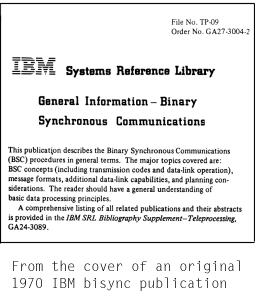What is Bisync?
A Short History Lesson
Bisync is an acronym shortened from "binary synchronous". Bisync is one of the names
commonly used when referring to a synchronous communications protocol introduced by IBM back in
1964 with the introduction of a product called the 270X Transmission Control Unit.
 The full name of the protocol is the "Binary Synchronous Communication"
protocol. This is usually abbreviated to "BSC". Whenever you see the terms "bisync" and "BSC" in conjunction with communications
protocols, they are referring to the same thing.
The full name of the protocol is the "Binary Synchronous Communication"
protocol. This is usually abbreviated to "BSC". Whenever you see the terms "bisync" and "BSC" in conjunction with communications
protocols, they are referring to the same thing.
Furthermore, over the years, other terms have come into use and are often used interchangeably with
bisync and BSC. For example, "3780 protocol", "3780 bisync", "2780 protocol", "2780 bisync", and "2780/3780 protocol". While
technically these terms may be inaccurate, they do have a practical basis and convey
meaning.
To be precise, 2780 and 3780 were model numbers of IBM remote job entry (RJE) data
terminals -- namely the
IBM 2780 Data Communications Terminal
and the
IBM 3780 Data Communications Terminal
. These terminals used punch cards and consisted of a card reader, a card
punch, and a line printer. These terminals used the bisync protocol
to transmit and receive data with an IBM mainframe computer. Usually dial-up or leased
telephone lines and 2400 baud Bell 201C,
and then later via 4800 baud Bell 208A/B, modems were used to connect the terminal
and mainframe.
The 3780 terminal was a later model and used a more robust
version of the bisync protocol -- hence the terms "3780 bisync" vs. "2780 bisync".
Virtually all bisync in use today conforms with the 3780 version.
So, what does this ancient protocol and these terminals have to do with today's PC and
Internet dominated world?
The reason amounts to something of a computing history lesson. While it is true
that IBM 3780 and 2780 terminals are
museum pieces today, the underlying bisync protocol became the defacto standard
file transfer protocol for a wide array of computing devices in the 1970's and
1980's. Much like Zmodem and FTP today, if you needed to get a file from one
machine to another during that time, very often the bisync protocol was
used.
And bisync wasn't strictly used in "pure" computers. The bisync protocol ended
up in ATM machines, check sorting machines, radar systems, cash registers,
and countless other devices.
This massive array of hardware does not disappear overnight. There is still a
huge installed base of bisync-equipped machinery in North America and to a
lesser extent in the rest of the world.
If somehow all of the bisync interconnected machines in the world were to stop
all at once, the results would be catastrophic. Many banks would cease to function.
Some air traffic control systems would collapse. Many of the point-of-sale
systems in retail stores would fail. Many credit and debit cards would become useless.
EDI (electronic data interchange) networks that manage much of the business-to-business
commerce would crash, We don't mean to suggest that there would be a
total collapse of all, or even most, of these systems but nonetheless, bisync
is still a vital link in the chain of the world's computer infrastructure.
Bisync is dying away, Slowly.
IBM abandoned bisync years ago in favor of its SNA (Systems Network Architecture)
connectivity model. (This lead directly to the IBM 377x terminal which was a
successor to the 3780 -- a diskette drive was added and bisync was replaced
with a new protocol compatible with SNA.) This abandonment, however,
did not erase the bisync protocol nor
its huge installed base. But it did open the door for specialty companies,
like Serengeti Systems, to expand into this niche market.
To some, it is remarkable that anything computer
related first used nearly fourty years ago, could still be in use
today. New equipment relying solely on bisync connectivity probably has not been
manufactured in more than a decade. Like the buggy whip, one day bisync will
pass into history. But, we can assure you that no one at Serengeti Systems
is holding their breath just yet...
Bisync questions? Call or e-mail us.
|




